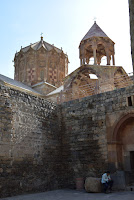I had been looking forward to visiting the Armenian St. Stepanos Monastery since the beginning of the trip and as we walked up the tree-lined alley leading to the main entrance I was surprised to realise the actual Monastery was surrounded by a fortress with a number of towers.
Once we sat on the Cathedral's yard listening to Mr. Rovillé's historic explanations before visiting it we were unexpectedly surrounded by people wanting to have their pictures taken with us or showing us children they had or would later baptize in the Cathedral.




Situated in a deep canyon along the Arax river which wouldn't be visible but later the ensemble is siad to have been built in the 9th century having been restored and rebuilt throughout the centuries and namely in the Safavid era. By the 14th and 15th centuries the Monastery was at the height of its cultural influence by producing paintings and illuminated manuscripts in religion, history and philosophy.
16th and 17th century miniatures were still visible in the central dome of the Cathedral, which owes its name to the first martyr of Christianity, who was stoned and killed for his Christian faith in the 1st century A.D. Many of the exterior walls are ornamented by traditional Armenian stone-crosses and inscriptions in memory of the thousands of Armenian benefactors who supported the Monastery in the course of history.
I was thoroughly impressed by the details of some of those decorations, which is something I had been expecting, having visited several Armenian churches in the past. Some of the stone-crosses depict the stoning of the Saint, whilst others the Annunciation of Virgin Mary and the Crucifixion of Christ among others.






I was equally impressed by its holy cross shaped interior, whose paintings are said to have been carried out by a renowned Armenian artist by the name of Honatanian.






Once we were outside I tripped over some tombs, as I listened to a gentleman singing a rather sad type of song in a heart-felt way whilst looking up at the sky and inspite of having had my camera fall onto the churchyard managed to use it soon after and as if under a mysteriously spell realised it hadn't got a single scratch on it ("Thank God or St. Stepanos ... otherwise I feel I would have been extremelly upset).
We were given some free time, in which Joelle and I strolled around not knowing exactly where to look, because everything seemed interesting, so after having climbed a pathway behind the actual Monastery so as to get a better view of the ensemble and its location and taken some photographs we decided to walk into the Monastery gift shop, in which I bought a few cards and a rather unique pair of traditional rope and woolen shoes, before heading back to the bus.









































No comments:
Post a Comment